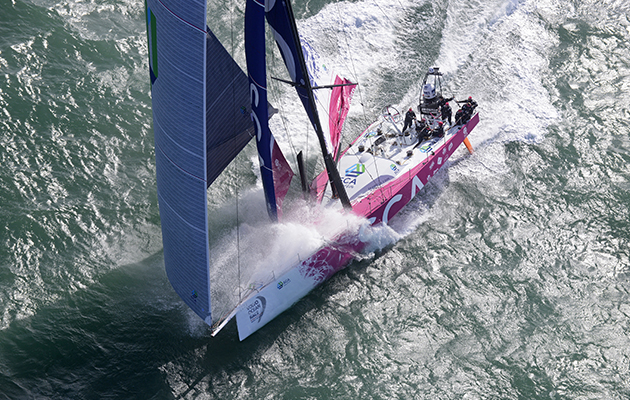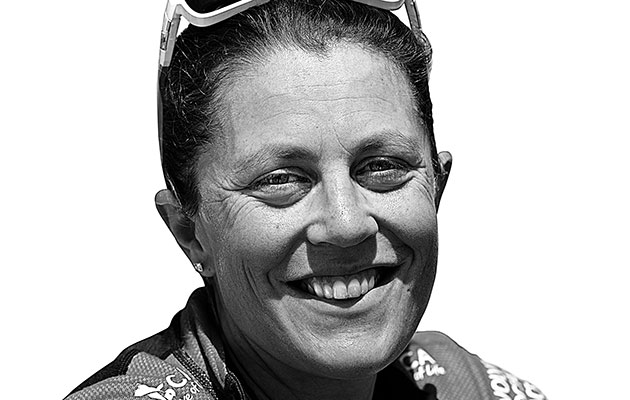Experienced ocean racer Sam Davies offers tips and advice on how to reduce the risk of MOB incidents such as this one seen in the 2015 Little Britain Challenge event on the Solent
It looks as though either a trimmer or the bowman has gone to leeward to check the trim or sheet leads for the headsail and potentially the impending spinnaker hoist. He has then slipped or lost his footing and seems to have fallen through the lifelines.
The rest of the crew are unaware, so it’s possible it will take a while for them to realise he is gone and that can have many consequences for this crewmember’s rescue and survival time, because the position of the MOB will be inaccurate.
It is quite likely that during his fall he hit the deck or stanchions so there is a risk of additional injury, most worrying being head injuries. If he was clipped on or part of his gear became tangled, there is a risk that he could be dragged along underwater, attached to the boat.
It also looks like a busy mark rounding so there is the potential for his being struck by another approaching yacht if he does end up in the water.
Man overboard! Everyone remain calm
The casualty needs to remain calm and conserve energy, and use all available items to remain as visible as possible. It is important not to panic as it may take a while for the boat to turn around.
Hopefully somebody saw him fall and that person must let the whole crew know what happened and remain the ‘spotter’. Ideally two people should be nominated for this job.
The crew should hit the MOB button on the instruments, release the MOB gear or anything that floats and is visible ASAP, stop and turn the boat immediately.
On board, the crew should listen to the skipper for instructions. All sails need to be dropped and secured properly to avoid further complications. The navigator should be able to help with a man overboard position and any drift/tidal information.
Once the recovery is underway, they should alert the Coastguard, and let the race organisation and all other yachts know to help avoid further injury or to help with recovery.
- Man overboard
Try to hang on as long as possible to alert the attention of others.
- Nominate spotters
On board nominate a spotter, ideally two, to keep a constant eye on the casualty in the water. Communicate with the helmsman.
- Drop/secure sails
Crew on board should prepare to drop/secure sails as soon as possible.
How to prevent man overboard emergencies
Losing someone overboard was my worst fear in the Volvo Ocean Race. We practised MOB and discussed the options a lot. The front of the boat is dangerous and the bowmen are nearly always clipped on, but the trimmers are the worst offenders for going to leeward (often not clipped on) without telling anyone, and on a VO65 it is an extremely dangerous place.

October 4 2013 – Team SCA sailing trials in the English Channel
Always inform someone if you are going to leeward or going to sort out something. Offshore or in difficult conditions it is important to let the helmsman know so that he keeps the boat as safe as possible. Generally during manoeuvres it is good to have a ‘buddy’ system so you have at least one person keeping an eye on you – often the mastman and bowman are ‘buddies’; the trimmer could tell the pitman, for example.
Good gear – especially grippy shoes – can help (the rubber non-slip hardens as they get older so keep an eye on them and replace). Kneepads can be lifesavers permitting you to lower your centre of gravity by crashing down on your knees to do the job without injury. A light deck or bow harness with a short strop that you can clip on and gain a free hand to do a tricky job on a bumpy day, is worthwhile.
A comfortable, well-fitting, regularly serviced lifejacket is essential. Ideally have a personal locator beacon (PLB). Some lifejackets have automatic PLB activation. We liked the AIS version as it enables the yacht and other vessels nearby to search immediately for the MOB. The EPIRB version is activated via the Coastguard once they have received the signal. We tested our AIS beacons in MOB drills and they worked well.
Further reading: Pip Hare’s choice of EPIRBs, PLBs and other man overboard aids
Carry a knife, a strobe and optional extras including a mini-pack of flares and fluroesceine dye (highly recommended by F24 French SAR pilots). On Team SCA our safety kit was in a bum bag because it was easy to grab and wear, even in hot conditions, and everybody obeyed this rule. We also had a rule to clip on as much as possible, and always in winds above 20 knots.
As a solo sailor, I am a big fan of harnesses and I often sleep in mine. In my experience, crews clip on a lot more if light deck harnesses are provided. However, one subject we discussed on the Volvo Ocean Race was the dangers of falling overboard in a harness when the boat is going very fast. Therefore, harnesses must be used with care. Attachment points and tether lengths (especially for the helmsman and mainsheet trimmer) need to be carefully designed so the crew cannot be washed overboard.
About Sam Davies

Sam (42) skippered the all-women Team SCA in the 2014-15 Volvo Ocean Race. She competed in the Vendée Globe twice, finishing a creditable 4th overall in 2009. She has numerous records to her name, including the all-women Round Britain speed record aboard Team SCA. She is now enjoying a welcome break with her young family and helping partner Romain Attanasio prepare for the 2016-17 Vendée Globe.




